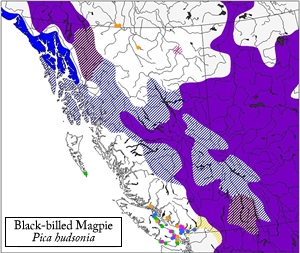The Black-billed Magpie is very distinctive and is virtually unmistakable.
| Commonly heard calls include a harsh, low-pitched rek rek rek rek or weg weg weg weg, a higher-pitched, nasal, rising jeeeek or meaaaah, and a rapid shek-shek-shek-shek. Also gives a longer, higher, nasal gway gway or gwaaaaaay and a nasal, hard, querulous ennk. All calls are noticeably harsh and often raspy. Source: Sibley (2000); Wood (2006b) |
Courtship
Pair formation typically occurs during the fall and winter. This species is monogamous, with pairs often remaining together for multiple years (sometimes for life). During courtship, the male circles the female and flashes the large, bold white patches in his wings while flaring his iridescent tail.
Nest
This species is sometimes loosely colonial, as suitable nesting sites are often patchily distributed on the landscape. Nest building begins during warm winter days (January-February in south, mid- to late April in far north). Both sexes contribute to the building of the nest, which takes 40-45 days to complete. The nest is usually placed in a low tree or shrub, although some pairs will build nests on artificial structures such as telephone poles or abandoned buildings. Nest heights range from ground-level to 18 m. The nest itself is a large (~1 m wide), sturdy, domed structure with an internal mud-lined cup. The nest and dome are constructed primarily of coarse, often thorny twigs and branches, although the nest chamber is largely composed of mud and dung with a lining of finer materials such as hair, rootlets, and weed stems.
Eggs
A clutch of (1) 5-7 (12) eggs is laid between early April and early June (late April to mid-May in far north), with most eggs laid in mid- to late April (south) or the first half of May (north). This species is single-brooded, although replacement clutches are sometimes laid if the first clutch is lost to predation. The eggs are incubated by the female alone for 17-22 days before hatching. The smooth, glossy eggs are tan to olive-brown with variable dark brown speckling and blotching that is sometimes concentrated towards the larger end. Eggs have been documented in B.C. between early April and late June.
Young
The young are altricial and naked upon hatching, with the pink skin quickly becoming yellowish and then grey; the mouth is deep pink and the gape flanges are pale pink. The nestlings are tended by both parents for 24-30 days before fledging. The young remain in the vicinity of the nest for 3-4 weeks following fledging, and are then tended by the parents for an additional 3-4 weeks before dispersing and becoming independent. Nestlings are present in B.C. between mid-April and mid-July, with dependent fledglings present into late July or August.
Source: Baicich and Harrison (1997); Campbell et al. (1997); Trost (1999); Sinclair et al. (2003)
|
Like many corvids, the Black-billed Magpie is omnivorous and opportunistic and selects a very wide diversity of food items. Carrion, ground-dwelling invertebrates (especially insects), and seeds/grains are the dominant food items that are consumed through the year, although it also preys on small mammals (usually mice and voles, rarely animals as large as ground-squirrels) and occasionally on the eggs and nestlings of other birds. Where it occurs near human habitation, it sometimes consumes garbage and refuse alongside other corvids such as crows and ravens. Carrion is a particularly important food source during the winter months in remote forested areas, and may represent one of the only sources of available food in these areas at that time of year. It also consumes ticks and other parasites off moose, deer, and other ungulates (especially during the winter), and will sometimes land on the backs of these animals in pursuit of these parasites. Most foraging occurs on the ground in open areas, with little foraging occurring in shrubs and trees. This species sometimes engages in kleptoparasitism, in which it steals food items from other birds. Where food is a limiting resource, this species often caches surplus supplies; unlike other species that cache food, however, most of these items are retrieved within 1-2 days of being cached.
Source: Trost (1999)
|
|

